#prison industries
Explore tagged Tumblr posts
Text

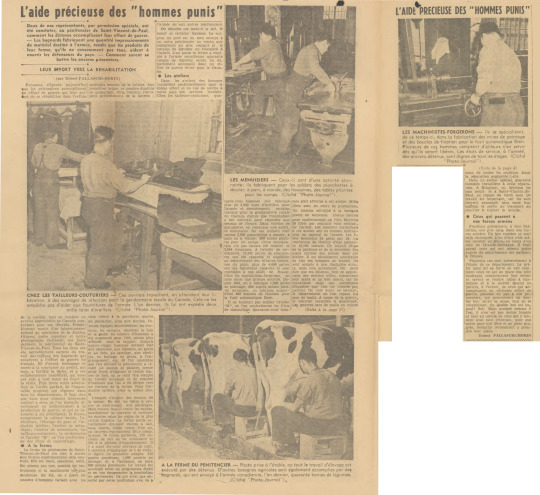
"L'EFFORT DE GUERRE DES "HOMMES PUNIS"," Photo-Journal. July 15, 1943. Page 1. ---- Grâce à un laisser-passer spécial, nos représentants ont pu aller constater, au pénitencier de Saint-Vincent-de-Paul, comment les détenus travaillent, eux aussi, pour notre commune victoire sur les forces de l'Axe. On lira ce reportage en page 4. Ci-haut, à gauche, photo prise dans l'atelier "M", où un prisonnier est à tresser un filet de camouflage, destiné à sauver des vies et du précieux matériel de guerre sous le feu de l'ennemi; ce filet aura réclamé, une fois terminé, la ligature de seize mille, cinq cents noeuds! A droite, des cordonniers réparent des souliers qui seront expédiés au département des Affaires indiennes ou à nos héroïques alliés de Russie. (Clichés "Photo-Journal". Voir article et autres vignettes en page 4). /// "A SAINT-VINCENT-DE-PAUL: L'aide précieuse des 'hommes punis'," Photo-Journal. July 15, 1943. Page 4 & 37. --- Deux de nos représentants, par permission spéciale, ont été constater, au pénitencier de Saint-Vincent-de-Paul, comment les détenus accomplissent leur effort de guerre. - Les bagnards fabriquent une quantité impressionnonte de matériel destiné à l'armée, tandis que les produits de leur ferme, qu'ils ne consomment pas tous, aident à nourrir les défenseurs du pays. - Comment savent se battre les anciens prisonniers. ---- LEUR EFFORT VERS LA REHABILITATION ---- (par Ernest PALLASCIO-MORIN) --- Personne n'ignore aujourd'hui que les prisonniers accomplissent un effort de guerre qui leur permet de se réhabiliter dans l'estime de la société, tout en rendant un service appréciable au Canada combattant pour ses libertés. Préalablement munis d'un laissez-passer spécial du ministère de la Justice, Ottawa, notre reporter et notre photographe visitaient, ces jours derniers, le pénitencier de Saint-Vincent-de-Paul. Tous les deux ont été agréablement surpris du travail merveilleux des bagnards qui coopèrent à l'effort de guerre du Canada. Et d'abord, hommage et merci à la courtoisie du préfet, qui nous a facilité la tâche, et à ses collaborateurs immédiats, qui nous ont aidé à tout noter au cours de la visite. Puis toute notre admiration de l'ordre parfait, de l'impeccable propreté qui règnent dans tous les départements. Il faut dire que nous nous sommes intéressés surtout à ceux où l'on travaille directement ou indirectement à la production de guerre, et qui se résument à six principaux: la ferme, comprenant la culture variée, l'aviculture, l'élevage du pore et l'industrie laitière; l'atelier de mécanique; l'atelier de menuiserie; les tailleurs-couturiers; la cordonnerie et l'atelier "M", où l'on confectionne des filets de camouflage.
A la ferme La ferme du pénitencier de Saint- Vincent-de-Paul n'a rien à envier aux fermes expérimentales déjà connues. Elle est vaste, spacieuse, outillée comme pas une, possède les instruments et la machinerie les plus modernes. En été, on y place un nombre d'hommes variant avec les multiples besoins de la culture. Aux premières neiges, ce nombre diminue en proportion. Cinq hommes s'occupent présentement de la laiterie; cinq volent à la porcherie, quatre, au poulailler, cinq aux écuries. Diverses équipes entretiennent les chemins, les caveaux, récoltent le foin et la paille. Ce nombre d'hommes a été augmenté pour l'été, saison plus affairée sous ce rapport. Jusqu'à quatre-vingts hommes doivent voir aux semences, aux légumes, au grain et au foin, au sarclage, aux récoltes, au battage du grain, à l'engrangement, etc. Si l'on considère que l'an dernier le pénitencier a récolté six poches de patates, trente mille livres d'oignons et trente tonnes de foin, on se rend vite compte du travail accompli et du nombre d'hommes que l'on a dû diriger vers les travaux de la ferme. Pour l'industrie laitière, c'est la même chose.
L'emploi s'inspire des besoins de la saison. En été, les bêtes à cornes se nourrissent aux pâturages. Mais encore faut-il traire les vaches, bouchonner les chevaux et nettoyer les écuries selon les règles de la plus stricte hygiène. La ferme garde actuellement dix-neuf vaches à lait, onze taures, douze veaux 'd'un an, un taureau reproducteur. On y compte aussi 70 truies portières, 170 cochons de lait ou en croissance et 310 à la période d'engraissement. Il y a aussi dix-neuf chevaux de trait, 2 chevaux d'équitation et 5 de volture légère. Le poulailler compte 310 poules pondeuses, 1,500 poulets en élevage: et, à l'automne, on aura 800 poules pondeuses. Le travail est accompli selon un programme établi et en vue d'augmenter la production du pénitencier. Ce qui n'est pas absorbé par cette institution s'en va à l'armée ou aux autres pénitenciers.
On absorbe ces mols-ci le lait, le bœuf et certains légumes. Le surplus du porc est ou bien envoyé à un autre pénitencier ou vendu aux emballeurs au prix courant et le surplus de légumes est transféré à l'armée. L'an passé la ferme a expédié à l'armée canadienne quarante tonnes de légumes variés. Ce département accomplit donc un effort de guerre direct pour le Canada.
Les ateliers Dans les ateliers, des hommes travaillent continuellement pour le même effort et en vue de rendre à notre pays des services louables. Chez les tailleurs-couturiers, quarante-trois hommes ont fabriqué plus de 2,000 taies d'oreillers pour l'armée et dernièrement certains travaux pour la gendarmerie royale du Canada depuis que l'institution a des contrats pour répondre aux besoins de l'heure. Dans l’atelier de menuiserie, on remarque une activité étonnante. De ces ateliers sont sorties 3,800 planchettes à dossier, à pain ou à viande; 600 tables pliantes pour les camps (cette consignation n'a pas encore été remise) et 3,944 houssines. A l'atelier de cordonnerie, 10,325 paires de chaussures ont été réparées et expédiées au département des Affaires indiennes du pays; plus de 4,000 paire sont été également réparées et sont expédiées à nos alliés de Russie. Chez les machinistes-forgerons, on note aussi une intense activité. Depuis 1941, on a fabriqué 1,028 mires de pointage; 906 autres seront, bientôt terminées; on fabrique aujourd'hui 400 boucles de fixation pour le fusil automatique Bren.
Il ne faudrait pas oublier l’atelier "M", où l'on confectionne les filets de camouflage. Quarante-neuf hommes sont affectés à cet atelier, Mille filets sont en cours de production. Un homme entraîné à la besogne prend en moyenne trente-heures pour confectionner un filet. Environ 30 filets par semaine vont ravitailler l'armée. Les hommes travaillant à cet atelier ont eu comme instructeur un caporal de l'armée. Les filets mesurent 24 pieds par 24. La confection de chacun d'eux nécessite 16,500 nœuds. Ce travail exige de la patience et de la dextérité. On place surtout des jeunes dans cet atelier. Il est absolument admirable de voir ces hommes au travail. Ils sont soumis à une discipline stricte, mais non accablante. On peut dire que ces détenus, tout en apprenant des métiers utiles, conservent leur santé et un bon moral, car ils travaillent dans des conditions d'hygiène que l'on ne trouve pas partout. On note aussi, en passant, le département où l'on répare les sacs de malle. A cause de la guerre, le courrier canadien a quadruplé. Les pauvres sacs de malle en volent donc de toutes les couleurs. Aussi la réparation augmente-t-elle.
Dans un atelier spécial, quarante hommes travaillent à cette réparation. A Kingston, on fabrique les sacs neufs et à Saint-Vincent-de-Paul, on répare les vieux sacs. Ce travail est important, car les sacs doivent accomplir sans cesse leur mission et servir au transport du courrier à travers le monde.
Ceux qui passent à nos forces armées Plusieurs prisonniers, à leur libération, ont pris rang dans nos forces armées. Un bon nombre se sont déjà distingués. L'un d'eux s'est même conduit en héros, au cours d'un raid en Grande-Bretagne. Il était parmi ceux qui ont obtenu grâce auprès du département des pardons, à Ottawa.
Plusieurs cas sont présentement à l'étude de ce département. Le préfet nous dit sa fierté de voir comment ceux en qui on place une telle confiance comprennent leur devoir et savent se rendre utiles à eux-mêmes et à la société. Quand on parlera, à l'avenir, de ceux qui accomplissent un véritable effort de guerre, pensons un peu �� nos prisonniers, qui poursuivent un double but: servir la cause, tout en se réhabilitant. Ce double but est imposé? Soit. Mais accepté comme il l'est, il n'en est pas moins louable et tout au mérite de ceux qui y tendent avec tant d'entrain, pour que notre pays soit libre et en plein progrès, lorsqu'ils reviendront y prendre leur place. Ernest PALLASCIO-MORIN
Légende page 4:
CHEZ LES TAILLEURS-COUTURIERS Ces ouvriers travaillent, en attendant leur libération, à des ouvrages de réfection pour la gendarmerie royale du Canada. Cela ne les empêche pas d'aider aux fournitures de l'armée. L'an dernier, ils lui ont expédié deux mille taies d'oreillers. (Cliché "Photo-Journal").
LES MENUISIERS Ceux-ci sont d'une activité étonnante: ils fabriquent pour les soldats des planchettes à dossier, à pain, à viande, des houssines, des tables pliantes pour les camps. (Cliché "Photo-Journal").
A LA FERME DU PENITENCIER Photo prise à l'étable, ou tout le travail d'élevage est exécuté par des détenus. D'autres besognes agricoles sont également accomplies par des bagnards, qui ont envoyé à l'armée canadienne, l'an dernier, quarante tonnes de légumes. (Cliché "Photo-Journal") Légende page 37:
LES MACHINISTES-FORGERONS Ils se spécialisent,de ce temps-ci, dans la fabrication des mires de pointage et des boucles de fixation pour le fusil automatique Bren. Plusieurs de ces hommes comptent d'ailleurs s'en servir dès qu'ils seront libérés. Les états de service, à l'armée, des anciens détenus, sont dignes de tous les éloges. (Cliché "Photo-Journal").
#st vincent de paul penitentiary#laval#montreal#war production#prison industries#prison industrial complex#convict labour#work will set you free#rehabilitation#life inside#photojournalism#canada during world war 2#crime and punishment in canada#history of crime and punishment in canada#war effort#total war
2 notes
·
View notes
Text

Adjusting things in prison.
95K notes
·
View notes
Text
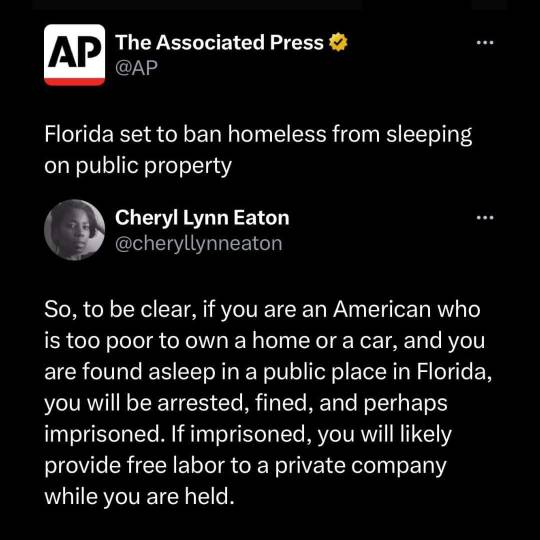
And who enforces this? Is it just a few bad apples, or is it all cops?
How hard is it for them to find cops willing to enforce this? Do they have to sift through hundreds of heroic cops who refuse until they find the one cop who's monstrous enough to enforce this, or do they easily find cops willing to enforce this because monstrous cops are everywhere and being a monster is part of the job?
"All cops are bad" is not a stereotype. It's literally a requirement for the job that every single one knew about.
29K notes
·
View notes
Text
PLEASE support The Innocence Project. Let the state sanctioned murder of Marcellus Williams radicalize you into caring about incarcerated people. Don’t let those in office that allow for this to defeat you. Incarcerated people are among the most violated and exploited class of people in the United States. We have built a justice system that benefits off of the mass incarceration of marginalized people. Incarceration is used to disenfranchise people. It is used for modern day slavery. Anyone can become incarcerated. It is the quickest and easiest way for your government to strip you of your rights.
20K notes
·
View notes
Text

#anti capitalism#scotus#news#democrats#republicans#politics#conservatives#britain#supreme court#biden#trump#usa#prison industrial complex#late stage capitalism
8K notes
·
View notes
Text
Studies about how giving people money is more effective at stopping homelessness than anything else are never actually going to make conservatives support UBI or anything like that. Under capitalism, homelessness is necessary as a threat to keep workers in line; you're more likely to accept bad wages and exploitation and abuse when the alternative is being thrown out into the street.
Homelessness is the stick that keeps the mule moving. The person riding the mule knows that the stick hurts it, that's the entire point.
#not even getting into things like the prison industrial complex#and how is used to funnel homeless people into prisons to be used as slave labor
7K notes
·
View notes
Text
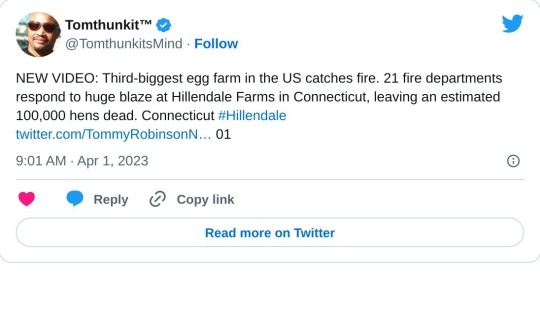
youtube
yet they say the impact from the fire was not predicted to raise prices, and we can all see that the egg industry is raking in record profits this year. some are reporting more than 750% increase in profits. This is gouging which is why I wonder why the egg industry is doing this in america.
heres something we bet you never realized ?
Since Emancipation, agriculture has moved its focus from one labor source to another in response to shifting currents of populism, nativism and racism. All three benefit from the exploitation of minority populations, and all three justify policies of exploitation in economic terms.
Arizona prisons partners with one of the countries largest egg farms?
youtube
these folks not only make egg products, but only cost the state $3.00 per hour in labor. America is the shithole of ethics
read this,
Farmers turn to prisons to fill labor needs
With immigration numbers low, the agriculture industry looks to another form of disenfranchised workers.
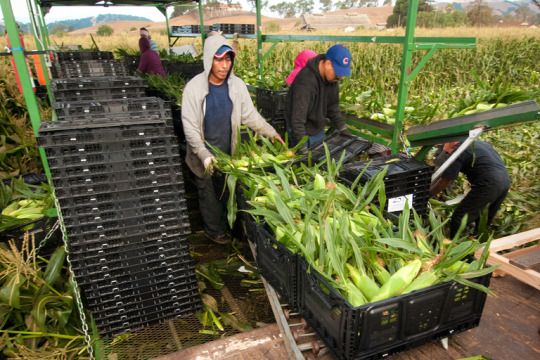
American agriculture often depends on migrant workers, like the one pictured here harvesting corn in Gilroy, California. But the anti-immigration policies of the Trump administration have farmers turning to prisoners to harvest labor-intensive crops.
Prison inmates are picking fruits and vegetables at a rate not seen since Jim Crow.
Convict leasing for agriculture – a system that allows states to sell prison labor to private farms – became infamous in the late 1800s for the brutal conditions it imposed on captive, mostly black workers.
Federal and state laws prohibited convict leasing for most of the 20th century, but the once-notorious practice is making a comeback.
Under lucrative arrangements, states are increasingly leasing prisoners to private corporations to harvest food for American consumers.
Why now?
The U.S. food system relies on cheap labor. Today, median income for farm workers is $10.66 an hour, with 33% of farm-worker households living below the poverty line.
Historically, agriculture has suppressed wages – and eschewed worker protections – by hiring from vulnerable groups, notably, undocumented migrants. By some estimates, 70% of agriculture’s 1.2 million workers are undocumented.
As current anti-immigrant policies diminish the supply of migrant workers (both documented and undocumented), farmers are not able to find the labor they need. So, in states such as Arizona, Idaho and Washington that grow labor-intensive crops like onions, apples and tomatoes, prison systems have responded by leasing convicts to growers desperate for workers.
The racist roots of convict leasing
Since Reconstruction, states have used prisoners to solve labor supply problems in industries such as road and rail construction, mining and agriculture. But convict leasing has also been a powerful weapon of white supremacy, and now, anti-immigrant sentiment.
After Emancipation, southern economies faced a crisis: how to maintain a racial caste system and a supply of surplus labor now that blacks were free.
Southern states passed vagrancy laws, Black Codes, and other legislation to selectively incarcerate freed slaves. For example, under Mississippi’s vagrancy law, all black men had to provide written proof of a job or face a $50 fine. Those who could not pay were forced to work for any white man willing to pay the fine — an amount that was deducted from the black man’s wage.
During the late 1800s, mass incarceration created an army of cheap labor that could be leased to private businesses for substantial profit. In 1886, state revenues from leasing exceeded the cost of running prisons by nearly 400%. Between 1870 and 1910, 88% of convicts leased in Georgia were black. In this Library of Congress photo from 1903, juvenile convicts are shown at work in the fields, location unknown. Library of Congress/Detroit Publishing Co.
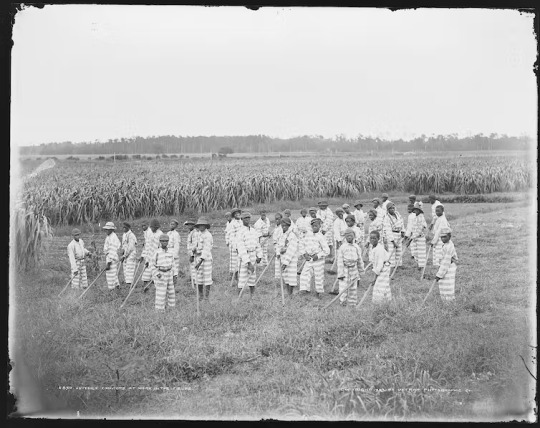
Populist response
But cheap convict labor also suppressed wages for free whites, and by 1900, poor whites began pushing back.
In 1904, James Vardaman was elected governor of Mississippi on a platform of returning whites to work and blacks to confinement. These populist white supremacist sentiments dovetailed with national economic concerns during the Great Depression, when agricultural failures led to widespread unemployment.
In the 1930s, the Ashurst-Sumners Act and accompanying state laws prohibited convict leasing and the sale of prisoner-made goods on the open market. Inmates still worked in agriculture, but the food they produced had to be consumed by other prisoners or state workers.
By the late 1970s, with growing competition from foreign manufacturing, U.S. companies sought out domestic sources of cheap labor.
Under pressure from corporate lobbies like the American Legislative Exchange Council, Congress relaxed restrictions on convict leasing with the Justice System Improvement Act. As the manufacturing and service sectors began hiring prisoners, agriculture expanded its use of migrant workers.
Profit and exploitation
Today, convict leasing offers significant revenues for prisons.
Most wages paid to inmates are garnished by prisons to cover incarceration costs and pay victim restitution programs. In some cases, prisoners see no monetary compensation whatsoever. In 2015 and 2016, the California Prison Industry Authority made over $2 million from its food and agriculture sector.
Growers can reap significant revenues, too. Inmates are excluded from federal minimum wage protections, allowing prison systems to lease convicts at a rate below the going labor rate. In Arizona, inmates leased through Arizona Correctional Industries (ACI) receive a wage of $3-$4 per hour before deductions. Meanwhile, the state’s minimum wage for most non-incarcerated farm workers is $11/hr.
Beyond the unfairness of low wages, inadequate state and federal regulations ensure that agricultural work continues to be onerous. Laborers endure long hours, repetitive motion injuries, temperature and humidity extremes and exposure to caustic and carcinogenic chemicals.
For inmates, these circumstances are unlikely to change. U.S. courts have ruled that prisoners are prohibited from organizing for higher wages and working conditions – though strikes have occurred in recent years.
Furthermore, inmates are not legally considered employees, which means they are excluded from protection under parts of the 1964 Civil Rights Act, the Equal Pay Act, the Fair Labor Standards Act, the National Labor Relations Act and the Federal Tort Claims Act.
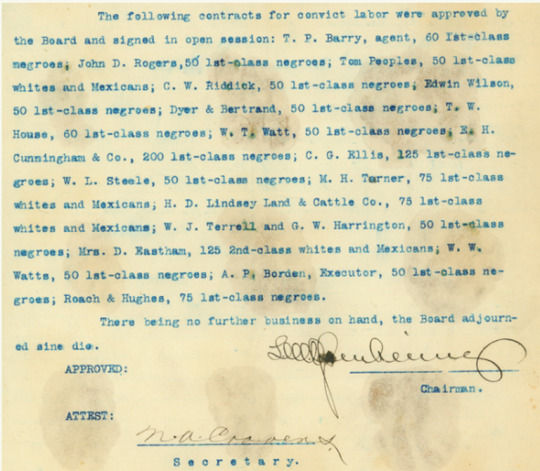
Excerpt from minutes of the regular meeting of the Texas Penitentiary Board, Nov. 12, 1903.
Whose labor is being sold?
The total number – and racial makeup – of leased inmates is difficult to calculate. Not all prison systems report on farming operations or leased labor arrangements. According to one advocacy group, at least 30,000 inmates work within the food system. But to the extent that convict leasing reflects overall inmate demographics, prison agriculture is distinctly racial.
Blacks make up 39% of inmates, but only 12% of the general population, making blacks six times more likely than whites to be incarcerated. Over the last 50 years – the same period that saw the return of convict leasing – the black incarceration rate quadrupled.
Proponents of “prison industries” argue that leasing provides rehabilitative benefits like on-the-job training for reentry. But research shows that within the prison system, whites receive better jobs than blacks, with better pay and more beneficial skills.
Whereas migrant workers often benefit home communities by returning a portion of their wages as remittances, the garnishing or nonpayment of convict wages prevents inmates from contributing to their families and home economies.
Since Emancipation, agriculture has moved its focus from one labor source to another in response to shifting currents of populism, nativism and racism. All three benefit from the exploitation of minority populations, and all three justify policies of exploitation in economic terms.
Convict leasing is the first – and now the latest – strategy.
#eggs#egg farms#chickens#prison industries#arizona#connecticut#Arizona Correctional Industries - Partnership with Hickman's Family Farms#Hillendale Farms#egg prices#egg price increases#record profits in egg business in 2023#Farmers turn to prisons to fill labor needs#Youtube
1 note
·
View note
Text

Article | Paywall Free
"Maryland Gov. Wes Moore issued a mass pardon of more than 175,000 marijuana convictions Monday morning [June 17, 2024], one of the nation’s most sweeping acts of clemency involving a drug now in widespread recreational use.
The pardons forgive low-level marijuana possession charges for an estimated 100,000 people in what the Democratic governor said is a step to heal decades of social and economic injustice that disproportionately harms Black and Brown people. Moore noted criminal records have been used to deny housing, employment and education, holding people and their families back long after their sentences have been served.
[Note: If you're wondering how 175,000 convictions were pardoned but only 100,000 people are benefiting, it's because there are often multiple convictions per person.]
A Sweeping Act
“We aren’t nibbling around the edges. We are taking actions that are intentional, that are sweeping and unapologetic,” Moore said at an Annapolis event interrupted three times by standing ovations. “Policymaking is powerful. And if you look at the past, you see how policies have been intentionally deployed to hold back entire communities.”
Moore called the scope of his pardons “the most far-reaching and aggressive” executive action among officials nationwide who have sought to unwind criminal justice inequities with the growing legalization of marijuana. Nine other states and multiple cities have pardoned hundreds of thousands of old marijuana convictions in recent years, according to the National Organization for the Reform of Marijuana Laws. Legalized marijuana markets reap billions in revenue for state governments each year, and polls show public sentiment on the drug has also turned — with more people both embracing cannabis use and repudiating racial disparities exacerbated by the War on Drugs.
The pardons, timed to coincide with Wednesday’s Juneteenth holiday, a day that has come to symbolize the end of slavery in the United States, come from a rising star in the Democratic Party and the lone Black governor of a U.S. state whose ascent is built on the promise to “leave no one behind.”
The Pardons and Demographics
Derek Liggins, 57, will be among those pardoned Monday, more than 16 years after his last day in prison for possessing and dealing marijuana in the late 1990s. Despite working hard to build a new life after serving time, Liggins said he still loses out on job opportunities and potential income.
“You can’t hold people accountable for possession of marijuana when you’ve got a dispensary on almost every corner,” he said.
Nationwide, according to the ACLU, Black people were more than three times more likely than White people to be arrested for marijuana possession. President Biden in 2022 issued a mass pardon of federal marijuana convictions — a reprieve for roughly 6,500 people — and urged governors to follow suit in states, where the vast majority of marijuana prosecutions take place.
Maryland’s pardon action rivals only Massachusetts, where the governor and an executive council together issued a blanket pardon in March expected to affect hundreds of thousands of people.
But Moore’s pardons appear to stand alone in the impact to communities of color in a state known for having one of the nation’s worst records for disproportionately incarcerating Black people for any crimes. More than 70 percent of the state’s male incarcerated population is Black, according to state data, more than double their proportion in society.
In announcing the pardons, he directly addressed how policies in Maryland and nationwide have systematically held back people of color — through incarceration and restricted access to jobs and housing...
Maryland, the most diverse state on the East Coast, has a dramatically higher concentration of Black people compared with other states that have issued broad pardons for marijuana: 33 percent of Maryland’s population is Black, while the next highest is Illinois, with 15 percent...
Reducing the state’s mass incarceration disparity has been a chief goal of Moore, Brown and Maryland Public Defender Natasha Dartigue, who are all the first Black people to hold their offices in the state. Brown and Dartigue have launched a prosecutor-defender partnership to study the “the entire continuum of the criminal system,” from stops with law enforcement to reentry, trying to detect all junctures where discretion or bias could influence how justice is applied, and ultimately reform it.
How It Will Work
Maryland officials said the pardons, which would also apply to people who are dead, will not result in releasing anyone from incarceration because none are imprisoned. Misdemeanor cannabis charges yield short sentences and prosecutions for misdemeanor criminal possession have stopped, as possessing small amounts of the drug is legal statewide.
Moore’s pardon action will automatically forgive every misdemeanor marijuana possession charge the Maryland judiciary could locate in the state’s electronic court records system, along with every misdemeanor paraphernalia charge tied to use or possession of marijuana. Maryland is the only state to pardon such paraphernalia charges, state officials said...
People who benefit from the mass pardon will see the charges marked in state court records within two weeks, and they will be eliminated from criminal background check databases within 10 months."
-via The Washington Post, June 17, 2024. Headings added by me.
#maryland#united states#us politics#cannabis#cannabis community#marijuana#pot#wes moore#democrats#voting matters#mass incarceration#prison#prison industrial complex#racism#discrimination#oppression#policing#social issues#pardons#legal system#background checks#prison system#good news#hope
1K notes
·
View notes
Text





Source
#prison industrial complex#abolish prisons#prisons#politics#us politics#government#the left#current events#news#data#criminal justice#criminal justice system#incarceration#activism#progressive
323 notes
·
View notes
Text
Guys you need to understand that the intersection of citizenship, ICE detainment, and the prison industrial complex is not about deportation. It is about slavery and labor. When somebody is arrested by immigration agents they are not immediately put on a plane and sent home. They stay in an interment camp where they must wait for a hearing by an immigration judge. There are not many of these judges and so people WILL be waiting for months if not years in these facilities.
The government is, and has for the past quarter century, been constructing the framework it needs to enslave noncitizen residents in America and force them into the private prison industry where their labor can be sold to companies for base production tasks. The goal here is to provide a fallback for when American global trading hegemony ends (because it will) and we no longer have access to cheap foreign labor markets. We are manufacturing cheap labor markets domestically by arresting immigrants and toying with citizenship status.
What’s happening NOW and TODAY is just a piece in a process that has been ongoing for decades, under both Democrats and Republicans. This is not new, it’s just being marketed to the public differently now that an R is in charge so that the public can feel absolved of guilt.
The immediate goal of the Trump policies now are to overwhelm the immigration judiciary to accrue a stockpile of detained people lacking documentation. Once there are so many (we are here) the government will say “we can’t handle all of this! there aren’t enough judges!” But it will not supply more judges to actually deport these people. This stage is all about normalizing the presence of hundreds of thousands of detained immigrants under your nose.
The next step is allowing these facilities to more easily sell and exploit their labor. I forsee this administration using environmental crises to do so - look at the LA wildfires. They are often fought by incarcerated firefighters. We will see more of this as crises escalate - the government will begin using more carceral labor to deal with the aftermath of hurricanes, landslides, and wildfires. This will normalize carceral slavery in the eyes of the American public.
Once this step is accomplished it will be incredibly simple to further the normalization in moments where there is not an acute crises. Then, we will be having people in these camps making our textiles, picking and packaging our food, slaughtering cattle. After years of this you may even see carceral labor enter the service and entertainment industry. By 2035 you may even be able to call up CoreCivic and lease a cook or a maid! The hard working white woman needs household assistance, after all she is too busy girlbossing to do *those* things. Plus, it’s not her fault her slave decided to be a Criminal.
But it seems like most Americans are not conscious of this framework nor do they care. They engage with this from the perspective that “everyone is welcome here! don’t deport my friends!” hon your friends are not going to be deported, they are being enslaved. Begging you to use your fucking eyes. Your damn Senators are investing in GEO Group and CoreCivic for a reason! Because these companies have a great business plan! Enslaving immigrants already is a billion dollar industry and its potential for growth under post imperial late stage capitalism is mind-numbing!
#us politics#fuck america#socialism#communism#leftist#politics#death to america#2024 election#prison#prison industrial complex#carceral system#carceral labor#Angela Davis#ice raids#donald trump
292 notes
·
View notes
Text

"Kingston Penitentiary Has Splendid Booth," Kingston Whig-Standard. September 5, 1933. Page 2. ---- The Kingston Penitentiary has a display in the main building of the Kingston Industrial Exhibition this year which is remarkably well arranged and which is attracting great attention from visitors to the Fair. The Penitentiary booth, decorated by photographs of the institution, contains products of the farm and the various industrial Departments of the institution. What is grown and what is made there is a revelation to many people as they view the exhibits.
Plants, flowers, vegetables, and other products of the farm and garden are exhibited in profusion while there are also, products of the machine shop, wood-working shop, mail bag department, shoe shops, etc. The exhibits are in charge of officers of the institution who are pleased to explain facts in connection with the various exhibits. The Penitentiary Is to be congratulated upon the excellence of the display.
#kingston ontario#kingston industrial exhibition#industrial exhibition#prison industries#prison industrial complex#convict labour#great depression in canada#crime and punishment in canada#history of crime and punishment in canada
1 note
·
View note
Text






#luigi mangione#monica bellucci#eat the rich#fuck corporate greed#ceo down#claims adjuster#prison industrial complex#legal matters#leftist memes#for legal reasons this is a joke#but it also isn't#fuck elon musk
629 notes
·
View notes
Text

The government imprisons people so capitalists can use them as slaves.
But for some strange reason, people think capitalism is freedom and anything else is big government tyranny.
783 notes
·
View notes
Text
168 notes
·
View notes
Text
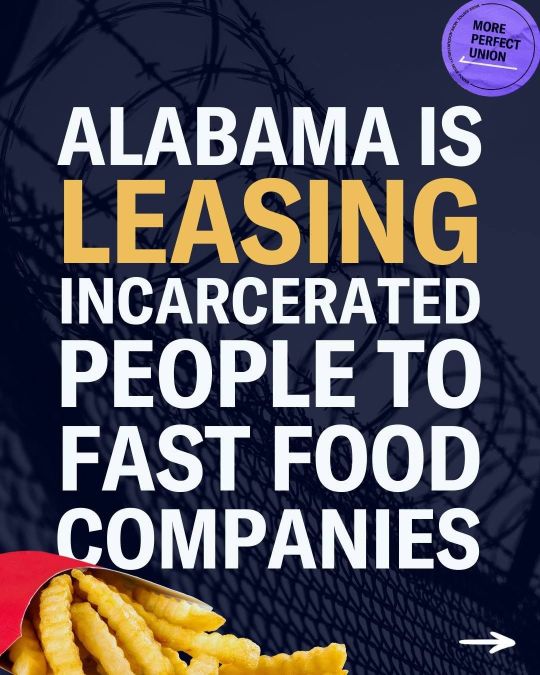

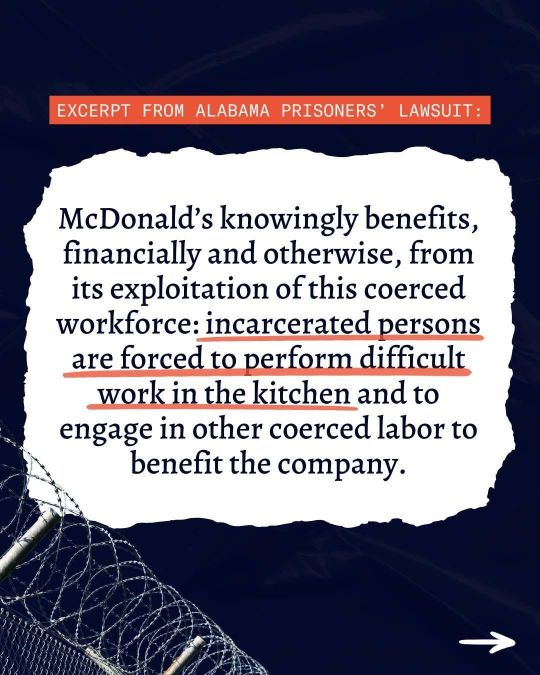




america has never been great and will never be great. it's a failed experiment from the start. and don't get it twisted, this is happening everywhere in this country.
746 notes
·
View notes
Text


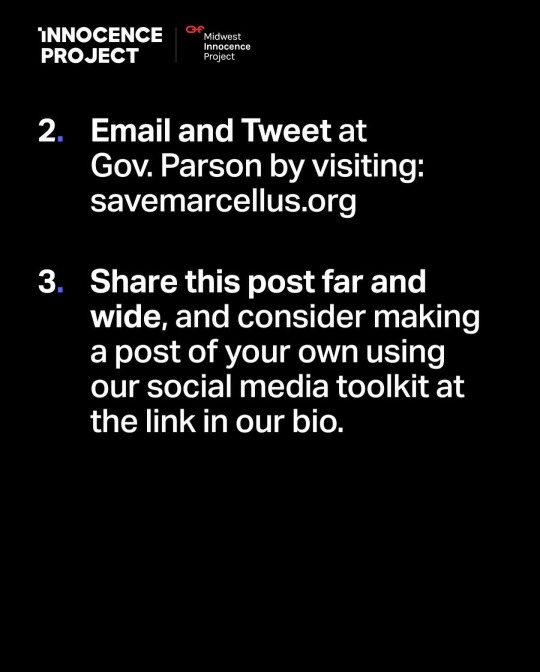
From @theinnocenceproject:
This is it. We only have 48 HOURS to stop Missouri from executing #MarcellusWilliams, an innocent man.
Every hour, every minute, every second is critical right now. And even though @GovParsonMO's office is closed today, we can’t let a single moment go by where we’re not urging him to take action. So today, we’re asking you to SHARE Marcellus’ story far and wide by creating your own post about him using the social media toolkit at the link in our bio, and include a call to action to sign our petition and call @GovParsonMO at 417-373-3400.
It is not too late for Gov. Parson to ensure that Missouri does not take an innocent man’s life.
#human rights#marcellus williams#stop the execution#death penalty#call to action#signal boost#black lives matter#prison industrial complex#Missouri#civil rights#the innocence project#justice#activism#urgent#capital punishment#no one is free until we are all free#prison abolition
183 notes
·
View notes